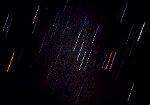 Star Trails in Orion.
This 15 minute image was taken with a 50mm lens using Fujicolor 200 film.
Star trailing brings out color beautifully; we've provided a labeled map
in the full size version to show the bright stars and their respective
colors.
Star Trails in Orion.
This 15 minute image was taken with a 50mm lens using Fujicolor 200 film.
Star trailing brings out color beautifully; we've provided a labeled map
in the full size version to show the bright stars and their respective
colors.
Please click each image for a full-size view.
 Star Trails in Orion.
This 15 minute image was taken with a 50mm lens using Fujicolor 200 film.
Star trailing brings out color beautifully; we've provided a labeled map
in the full size version to show the bright stars and their respective
colors.
Star Trails in Orion.
This 15 minute image was taken with a 50mm lens using Fujicolor 200 film.
Star trailing brings out color beautifully; we've provided a labeled map
in the full size version to show the bright stars and their respective
colors.
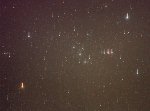 Orion at Light Speed. This picture was an accident! Somehow it turned
out as a combination between a star trail and a piggyback image. It reminds
me of what you would see if you happened to be looking out the viewport of the
Millenium Falcon as it went to lightspeed. This image was captured
with far more earthly means, however; it was exposed 12 minutes piggybacked
to the Meade 8-inch using Fujicolor 200 film. Location: OCO, 11/17/98.
Orion at Light Speed. This picture was an accident! Somehow it turned
out as a combination between a star trail and a piggyback image. It reminds
me of what you would see if you happened to be looking out the viewport of the
Millenium Falcon as it went to lightspeed. This image was captured
with far more earthly means, however; it was exposed 12 minutes piggybacked
to the Meade 8-inch using Fujicolor 200 film. Location: OCO, 11/17/98.
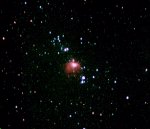 Orion's Belt and Sword. This 20 minute exposure highlights the lower half
of Orion. His three belt stars (Alnitak, Alnilam, and Mintaka) are visible
at top, while M42 stands out as a bright pinkish patch in the middle of
the belt. This image was taken with a 135mm lens using Kodak Royal Gold
1000 film. The camera was piggybacked on the C-11. Location: OCO, October
1998.
Orion's Belt and Sword. This 20 minute exposure highlights the lower half
of Orion. His three belt stars (Alnitak, Alnilam, and Mintaka) are visible
at top, while M42 stands out as a bright pinkish patch in the middle of
the belt. This image was taken with a 135mm lens using Kodak Royal Gold
1000 film. The camera was piggybacked on the C-11. Location: OCO, October
1998.
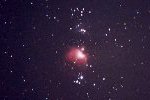 The Hunter's Sword. Here we move in a little closer to M42, and more detail
becomes visible. Also note the star clusters above and below, and a hint of
nebulosity to the north. This image was exposed 6 minutes on Kodak Royal
Gold 1000 film, using a 300mm lens. Location: OCO.
The Hunter's Sword. Here we move in a little closer to M42, and more detail
becomes visible. Also note the star clusters above and below, and a hint of
nebulosity to the north. This image was exposed 6 minutes on Kodak Royal
Gold 1000 film, using a 300mm lens. Location: OCO.
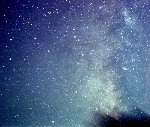 2 Views of the Sagittarius Milky
Way. The first image, a 20 minute exposure, was taken with a 50mm lens and Kodak Gold 400 film,
and the camera was piggybacked on the C-11. A 15mm eyepiece was used to guide the scope during the exposure. Location: OCO, August 1998.
The second image was taken with a 35mm lens using Kodak Gold 1000 film. It's a
30 second exposure, with the camera mounted on a tripod and equipped with a cable release. Location:
near Jeffersontown KY, June 1997.
2 Views of the Sagittarius Milky
Way. The first image, a 20 minute exposure, was taken with a 50mm lens and Kodak Gold 400 film,
and the camera was piggybacked on the C-11. A 15mm eyepiece was used to guide the scope during the exposure. Location: OCO, August 1998.
The second image was taken with a 35mm lens using Kodak Gold 1000 film. It's a
30 second exposure, with the camera mounted on a tripod and equipped with a cable release. Location:
near Jeffersontown KY, June 1997.
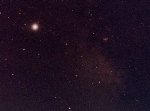 Jupiter visits the Milky Way. In 1996, the giant planet Jupiter glided
through the stars of the Sagittarius Milky Way region. These 2 images present
different views of the giant planet under different sky conditions. Both
these images were taken with a 50mm lens and Kodak Royal Gold 1000 film. Each
image is a 12 second exposure, and the "garbage bag" method was used (described
in the previous image notes). Location: OCO.
Jupiter visits the Milky Way. In 1996, the giant planet Jupiter glided
through the stars of the Sagittarius Milky Way region. These 2 images present
different views of the giant planet under different sky conditions. Both
these images were taken with a 50mm lens and Kodak Royal Gold 1000 film. Each
image is a 12 second exposure, and the "garbage bag" method was used (described
in the previous image notes). Location: OCO.
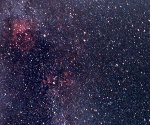 2 Views of the Milky Way in Cygnus. Many bright red nebulae are visible in these images, including the North America
and the Butterfly or Gamma Cygni. These are surrounded by bright Milky Way star
clouds. The bright star at lower right in the first image is Vega, part of the small
constellation Lyra. Both these images were taken with a 50mm lens using Kodak Royal
Gold 1000 film, with the camera piggybacked to the C-11. Location:OCO.
2 Views of the Milky Way in Cygnus. Many bright red nebulae are visible in these images, including the North America
and the Butterfly or Gamma Cygni. These are surrounded by bright Milky Way star
clouds. The bright star at lower right in the first image is Vega, part of the small
constellation Lyra. Both these images were taken with a 50mm lens using Kodak Royal
Gold 1000 film, with the camera piggybacked to the C-11. Location:OCO.
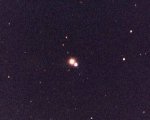 Albireo, the Head of the Swan. This beautiful double star is one of the
showpieces of the summer sky. Albireo, or Beta Cygni, is 1 star to the naked
eye, and 2 in a telescope. These two stars orbit each other in space, at a
distance many times greater than Pluto is from the Sun. These two stars appear
yellow and blue through most telescopes; what color are they to your eye?
This 1 second image was taken through the C-11 on Kodak Royal Gold 1000 film.
Location:OCO
Albireo, the Head of the Swan. This beautiful double star is one of the
showpieces of the summer sky. Albireo, or Beta Cygni, is 1 star to the naked
eye, and 2 in a telescope. These two stars orbit each other in space, at a
distance many times greater than Pluto is from the Sun. These two stars appear
yellow and blue through most telescopes; what color are they to your eye?
This 1 second image was taken through the C-11 on Kodak Royal Gold 1000 film.
Location:OCO
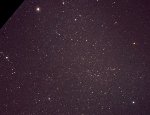 Auriga the Charioteer. Although its hard to see a charioteer in this
constellation, it's much easier to see a pentagon, which makes Auriga a
conspicuous sight in the winter sky. This image was taken on the night of November 16th,
1998, in hopes of capturing a Leonid meteor. It was taken with a 50mm lens using
Fuji 200 film, and exposed for 10 minutes riding piggyback on the Meade 8-inch.
Location: OCO.
Auriga the Charioteer. Although its hard to see a charioteer in this
constellation, it's much easier to see a pentagon, which makes Auriga a
conspicuous sight in the winter sky. This image was taken on the night of November 16th,
1998, in hopes of capturing a Leonid meteor. It was taken with a 50mm lens using
Fuji 200 film, and exposed for 10 minutes riding piggyback on the Meade 8-inch.
Location: OCO.